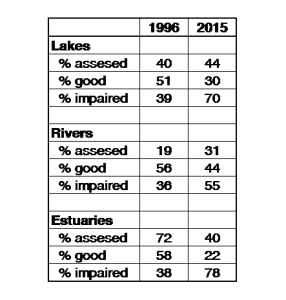Our family gatherings often involve interesting discussions (aka arguments) on politics, religion or other fun topics. Occasionally the conversations stray into the environmental arena. Although many in my family argue against “big government” getting in the way of everything, they have had to agree that some federal regulations like the Clean Water act and the Clean Air Act have had some major benefits. Older members of my family admit that when they were younger, they would not have dreamed of swimming in or eating fish from many local rivers or lakes. No longer do we have rivers catching fire; in general our local waters are much cleaner today than they were 50 years ago, thanks to regulation of sources of pollution to these waters.
With new stormwater regulations hitting communities in Connecticut (“MS4”), I thought I would take a quick look to see what changes have taken place in our nation’s waters in the last 20 years. The Clean Water Act regulations require that states report every two years on the quality of waters in their jurisdiction (Water Quality Reports to Congress). These assessments are tied to the “Designated Use” of the waters, and at a minimum need to provide a fishable/swimmable condition, and also be able to support aquatic life. Other waters have more restrictive uses like drinking water supplies. Waters are assessed as to whether they are meeting the designated uses established for that stream/river, lake, or estuary.
Here is a summary of the results from 1996 and from 2015:
So the answer is no…I did not mix up the years. Unfortunately, when we compare the most recent report from that of 20 years or so, fewer water bodies have been found to be in good condition, and more have been found to be impaired. Now as a disclaimer, the same water bodies do not necessarily get tested every year; a certain percentage of waters get assessed every two years. It does appear that we are assessing a higher percentage of lakes and rivers, but a smaller percentage of estuaries. The reports also list the primary sources of impairments. The top source is either atmospheric deposition (lakes and estuaries) or agricultural operations (rivers). Stormwater is also one of the leading sources of impairment for all water bodies. These findings highlight two important things: first, our air quality is heavily linked to our water quality. Power plant and industrial emissions clearly do have an impact on the quality of our nation’s waters. Second, stormwater continues to be a problem. So, although nobody likes dealing with more regulation or bigger government, I am hopeful that the new, more stringent MS4 regulations in Connecticut and other states will make a difference, so that in 20 years my daughter can look back in disbelief at how dirty our waters are now, and how much they have improved.

